A Quetico Solo, August 2008
by UncleMoose
Day 2 - Prairie Portage and Louisa Lake (Monday, August 4) [full index]
11.2 miles, 7 portages
Pre-trip excitement impeded a deep night of sleep, and I was wide awake by 5:30 a.m., a half hour before the alarm. The morning was warm, humid and overcast. The air was heavy with mist and occasional drizzle. I spent my extra time reviewing the first day's route while munching on some Clif Bars. Then I untied the canoe from the top of the car, moved the car to the entry point parking lot, and carried my gear down to the docks where the tow boats were waiting.
Moose Lake is one of the few boundary waters lakes where the use of motor boats (25 horsepower maximum) is allowed. For a fee, an outfitter will tow you, your canoe and your gear in a small motorized boat to the Canadian ranger station at Prairie Portage. Before entering Quetico directly from the United States, all paddlers must first check-in to a Canadian ranger station to pick up their travel permits. The permit is only valid for the exact entry day it is reserved for, so if you fail for any reason to pick it up on that day, during the hours when the ranger station is open, your trip is basically over before it even starts. For this reason, and because I also wanted to get an early start, I opted for the motorized tow to Prairie Portage. After months of planning I did not want to tempt fate, mother nature, or any other potential obstacle by requiring that I first paddle the six or so miles between LaTourell's and the ranger station.
The tow boat driver showed up before long, and together we loaded my gear into the boat. The word "tow" might suggest to some that the canoe gets pulled behind the motor boat, but this is not the case (at least not these days). Most tow boats have a built-in rack on which the canoes are placed. Passengers and gear then sit underneath the canoes.
I had expected to share the boat with other paddlers this morning, but as it turned out I was this boat's only passenger today. So once my gear was aboard, the driver headed straight out onto Moose Lake, pointed the boat north, and let all 25 horses go. If I hadn't already been fully awake by then, the mist and drizzle now hitting my face quickly took care of that. Before long the few signs of civilization that do exist at the south end of Moose Lake disappeared, and the untamed landscape of the boundary waters quickly took over. In that early morning mist and low light the large, shadow-like silhouettes of passing islands and trees looked particularly bold and wild. I could already feel myself starting to move into that wilderness frame of mind, a certain exhilaration and heightened sense of awareness that ordinarily seems to lay dormant, as if hiding from the regular commotion and sensory overload that is modern life.
After about twenty minutes at full speed the boat made a turn west toward Prairie Portage and slowed. Signs along the shore welcomed us, first to Canada and then to Quetico. The driver eased the boat past a line of buoys marking the top of a dam and then pulled close to shore. We both jumped out into the shallow water and began unloading the gear onto the gravel landing. Within minutes I was thanking the driver as he jumped back into his boat. He put the motor into gear and quickly disappeared around a bend.

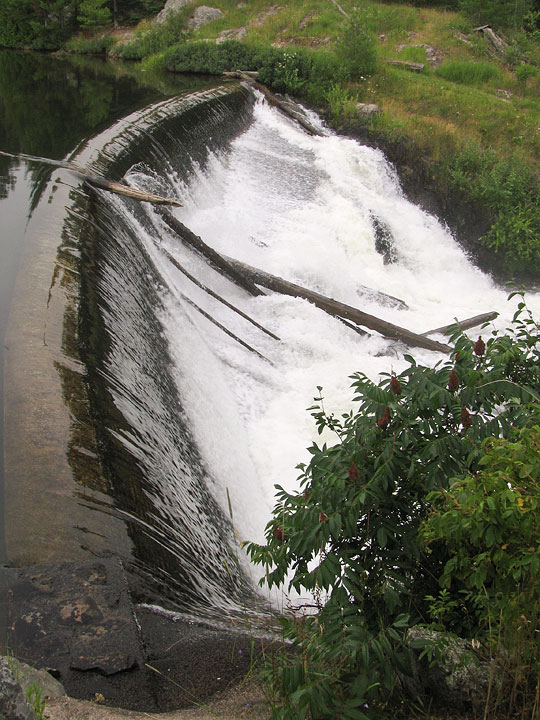
At the landing I spent a few minutes getting my equipment and canoe ready for portaging. The ranger station was still on the other side of a short trail connecting Sucker Lake on the U.S. side with Basswood Lake's Inlet Bay on the Canadian side.
My gear consisted of the following items:
- Wenonah Wilderness solo canoe (royalex)
- Three packs (food pack, camp pack and a small day pack)
- Two paddles (primary bent shaft and a backup straight shaft)
- Two fishing rods (light rod for jigging and a heavier one for casting)
- Map case with clipped-on GPS and SPOT locator device
- Padded canoe seat
- Removable solo portage yoke
- PFD (personal floatation device)
- Bailer and sponge (tied to the bow)
- Mesh anchor bag (tied to the stern)

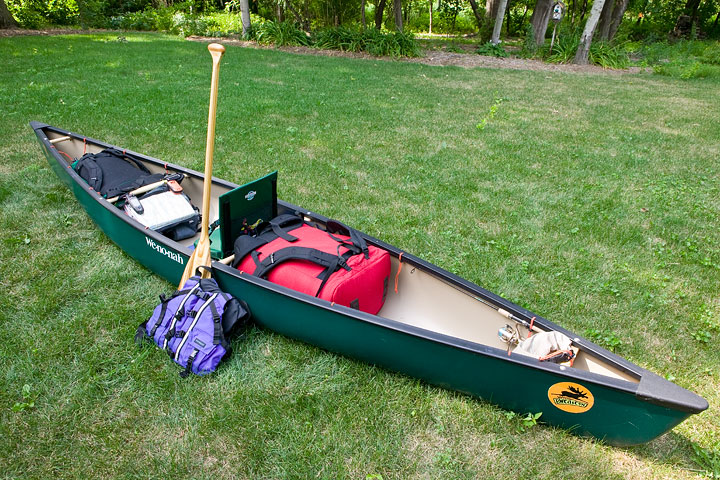
Normally, the backup paddle, fishing rods, bailer, sponge and anchor bag all remained tied to the sides of the canoe.
In paddling mode the heavier food pack was placed behind my seat, the camp pack was set in front, and the day pack was wedged between my feet. The map case was attached to the canoe's front thwart and rested on the day pack, giving me an optimal viewing angle at the maps and GPS while giving the SPOT a clear view of the sky. The padded seat was strapped to the canoe's standard webbed seat, and the portage yoke was bungeed underneath. My PFD was worn at all times while on the water, and the bent shaft paddle was, well, used to paddle.
In portage mode the packs and map case were removed from the canoe, the padded seat and portage yoke were reversed, the PFD got clipped to the top of the food pack, and the bent shaft paddle got bungeed to the inside of the canoe. I double portaged, which means I carried my gear over the trail in two shifts. On the first trip I would typically take the canoe and camp pack. Then, after a leisurely walk back, I would hoist the food pack onto my shoulders, hug the day pack with attached map case to my chest, and hike back over again.
After performing the first portaging ritual of this trip I arrived at a rare sand beach flanked by a couple of small buildings. To one side was the older ranger station where permits used to be issued, and on the opposite side was a newer structure that served as both a small gift shop and the new place to pick up permits. Seeing a complex of buildings in such a remote place seemed odd, but it was really just an anomaly, a small island of civilization on the doorstep of wilderness.

Thanks to my early start, the line at the permit issuing station was short. One group was already inside when I arrived, and a fishing guide was the only other person ahead of me. We talked a bit about my trip as we waited in line outside the building, and he gave me a few pointers about the fishing on some of the lakes along my route. A short time later I was inside the station myself, filling out the necessary paperwork and paying the fees. With permit and fishing license now in hand, I was finally set loose upon Quetico.
The line outside the ranger station was already growing as I left the building and headed for the beach. By now the sun was starting to push the drizzly gray skies away, and I quickly prepared the canoe for paddling. Just before shoving off an older gentleman nearby asked if I was headed for Sunday Lake, and I responded that I was. Then he asked if I was planning to take the more difficult North Portage from Bayley Bay directly into Sunday Lake, or whether I was going to take the easier, but longer "scenic" route through Burke Lake. I had earlier struggled with this choice but had finally decided to take the scenic route. I had heard rough things about North Portage, and with a fully loaded food pack I did not want to start my trip on a negative note. The gentleman expressed his agreement with my logic and confessed that his group had reached a similar conclusion.
After a brief discussion about GPS devices I finally shoved off around 9 a.m. At first, I felt a little clumsy in the new solo canoe. I had done some limited paddling with it and my new bent shaft paddle beforehand, but it still felt awkward. With the canoe now fully loaded I found myself struggling to get comfortable with my leg positioning. At first I thought kneeling would be better, but as the day progressed I found that extending my legs out in front, with feet braced against the front pack, was much more comfortable and effective.
As would be expected, there was a fair amount of canoe traffic heading in and out of Prairie Portage through Bayley Bay. When I reached the first portage connecting the bay to Burke Lake I encountered a group taking a short break, apparently a father with some kids and a dog. I landed my canoe a little further down the long sandy shoreline to give them some space, but we ended up sharing the portage trail anyway. It was no problem, though, as the trail was a relatively easy one. We were both headed for Agnes Lake, and as I left them at the landing on Burke, I figure our paths would likely cross again, me being the slower solo paddler.
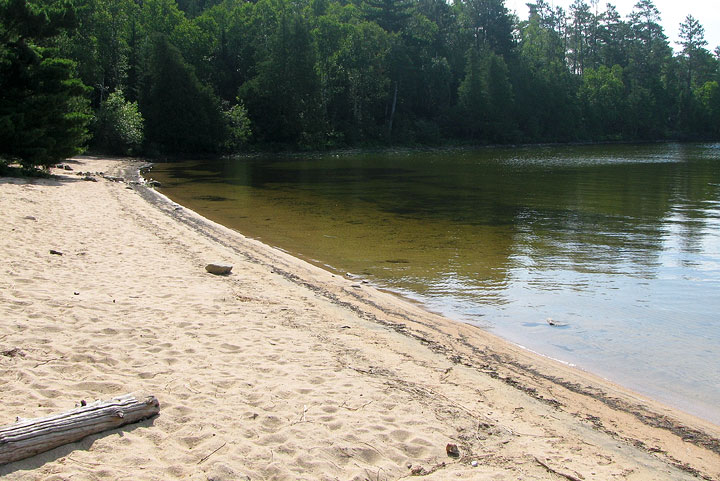
I made good time paddling east across the south arm of Burke Lake, and soon I was carrying my gear over the short and pretty Singing Brook portage leading to Sunday Lake. Another workman-like paddle across Sunday Lake brought me to the first of the Meadows Portages. The Meadows Portages had a reputation for being long and tough, and they would give me my first true taste of real Quetico portaging.
Before reaching the landing for the first Meadows Portage connecting Sunday Lake with Meadows Lake, I had noticed the group from Burke Lake finally catching up. On the uneven portage trail, paved with ankle-busting rocks, I encouraged them to move ahead as I struggled to make my second trip over with the heavy food and day packs. Nineteen days worth of food and fuel weighed a lot, and adding a day pack bulging with heavy camera equipment certainly didn't help. It was clearly going to take a few days for me to find my portage legs on these challenging Quetico trails.
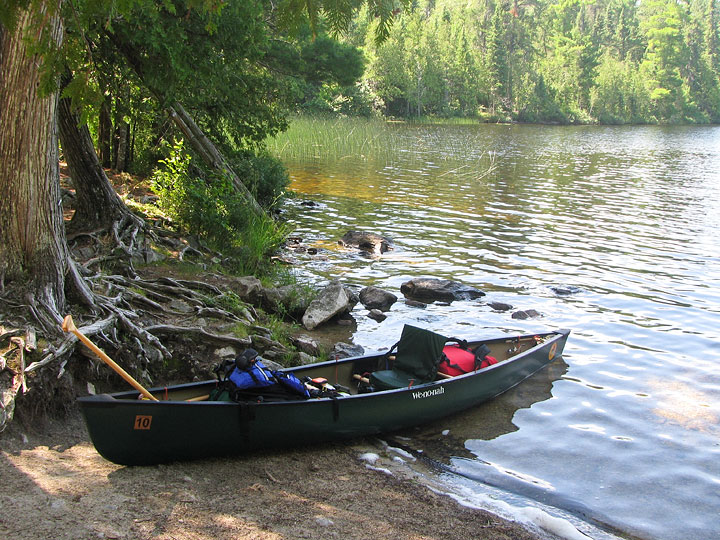
On the other side of the first Meadows Portage I spent some extra time floating around on Meadows Lake. Part of my objective was to give the group ahead of me a larger head start and a bit more space before heading in to tackle the second Meadows Portage myself. My other motivation was to take a small break and rehydrate a bit. However, as I was lounging in my canoe, a new group emerged from the previous portage, so I figured it was probably a good time to head back in and stop procrastinating.
I shared the second Meadows Portage with that new group, a father and son team from Central Illinois. At the Agnes Lake end of the portage I stopped to talk with the father before shoving off. They were headed up Agnes to do some fishing, and he showed me the location of some petroglyphs further north. I was headed in a different direction but nonetheless took note of where the petroglyphs were located. I discussed water filtration with the man, and I remember him saying that the day he could no longer drink unfiltered water directly from the lakes of Quetico was the day he would no longer return.

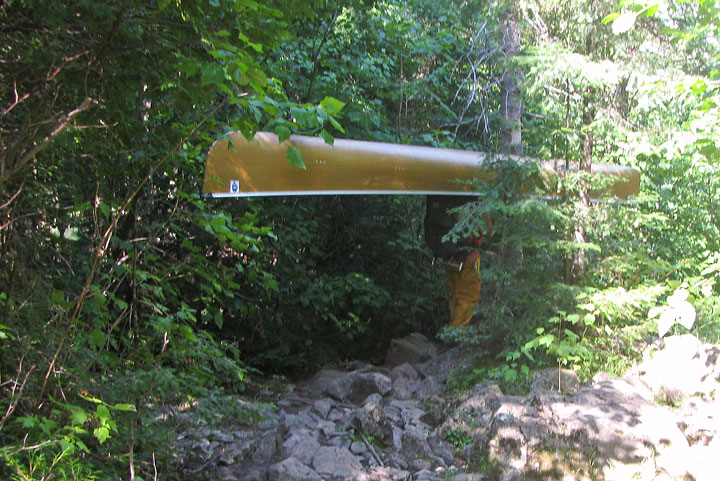
After a short paddle north on Agnes, the landing at Louisa Falls came into view. I had heard that this could be a busy place in summer, and the many canoes I saw piled up on shore soon confirmed this. I had expected to see a fair amount of people on this first day of travel, but the swarm of young people I saw crawling all over the base of the falls was almost comical, especially considering the remoteness of the place. The falls' popularity is understandable, though, as it is quite beautiful and features a unique attraction called the "bathtub". The bathtub is a pool about midway up the falls that you can sit in as water cascades down upon you. On a hot summer afternoon it's an ideal place to cool off.

I really had to work to get my canoe up on the steep rock ledge to the right of the falls. The other canoes that were already resting there definitely did not help matters. When I arrived, the bathtub was full of a group of young women, and the campsite adjacent to the falls was occupied by a group of three young men. Clearly these guys knew what they were doing.

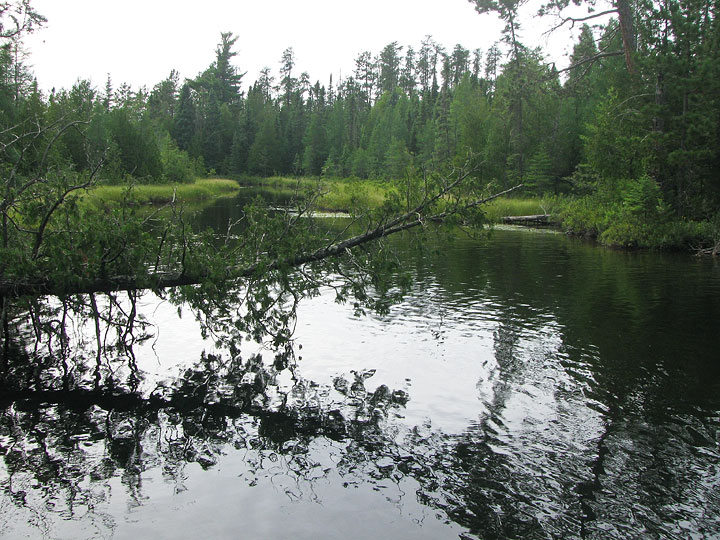
Due to the crowds and lateness of the day, I decided to forgo a soak in the tub this time and instead got started dragging my gear up the extremely steep portage trail alongside the falls. It took me a few trips, but I eventually got everything up to the quiet little landing at the top of the falls. After a short paddle across a small creek, I hiked the gear over one more portage and soon emerged onto big Louisa Lake. The roar of the falls was now gone, and in the void left behind was only quiet. For the first time on this trip I really felt like I was finally alone.
I paddled a short way up on Louisa Lake and found a nice campsite on a point. Sections of the point were carpeted with ripe blueberries just begging to find their way into tomorrow's oatmeal. The day was rapidly coming to an end, so I quickly set up camp and ate. The evening was warm and pleasant, and after a long first day of travel I was happy to finally get a chance to sit back and relax. Loons paddled around the point and sang. Though bugs had not been a problem earlier in the day, I eventually found myself diving for the safety of the tent as a cloud of mosquitos descended around me.


Videos (click on an image below to play)
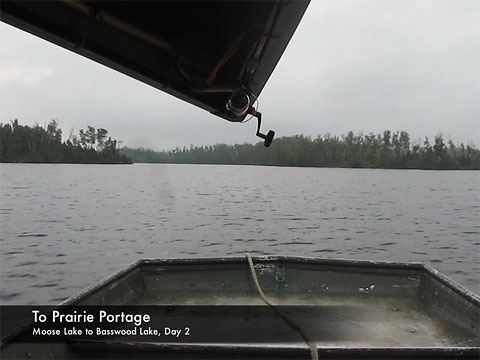


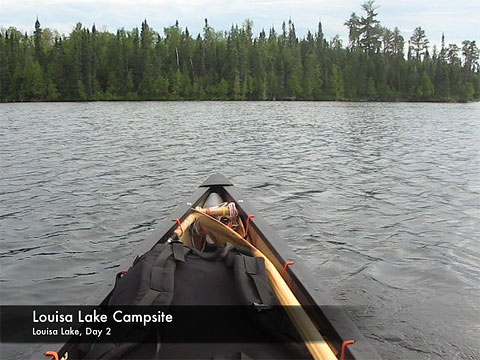
Click here for the fully formatted report

 Donate - BWCA.com
Donate - BWCA.com